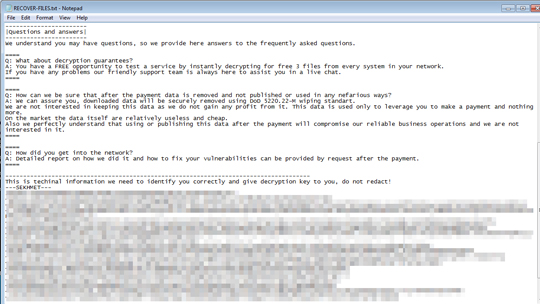Ransom.Win32.SEKHMET.A
W32/Cryptor.DDU!tr (FORTINET); Trj/GdSda.A (PANDA)
Windows


Threat Type: Ransomware
Destructiveness: No
Encrypted: Yes
In the wild: Yes
OVERVIEW
Downloaded from the Internet
This Ransomware arrives on a system as a file dropped by other malware or as a file downloaded unknowingly by users when visiting malicious sites.
It connects to certain websites to send and receive information. However, as of this writing, the said sites are inaccessible.
It drops files as ransom note. It avoids encrypting files with the following file extensions.
TECHNICAL DETAILS
709,632 bytes
DLL
No
23 Mar 2020
Connects to URLs/IPs, Terminates processes, Encrypts files, Displays message/message boxes
Arrival Details
This Ransomware arrives on a system as a file dropped by other malware or as a file downloaded unknowingly by users when visiting malicious sites.
Installation
This Ransomware drops the following files:
- %ProgramData%\syscfg.db
- {Encrypted Directory}\{8 random characters}.lnk -> deleted afterwards
(Note: %ProgramData% is a version of the Program Files folder where any user on a multi-user computer can make changes to programs. This contains application data for all users. This is usually C:\ProgramData on Windows Vista, 7, 8, 8.1, 2008(64-bit), 2012(64-bit) and 10(64-bit), or C:\Documents and Settings\All Users on Windows Server 2003(32-bit), 2000(32-bit) and XP.)
It adds the following mutexes to ensure that only one of its copies runs at any one time:
- Global\{16 characters}
Process Termination
This Ransomware terminates the following processes if found running in the affected system's memory:
- msftesql.exe
- sqlagent.exe
- sqlbrowser.exe
- sqlwriter.exe
- oracle.exe
- ocssd.exe
- dbsnmp.exe
- synctime.exe
- agntsvc.exe
- isqlplussvc.exe
- xfssvccon.exe
- sqlservr.exe
- mydesktopservice.exe
- ocautoupds.exe
- encsvc.exe
- firefoxconfig.exe
- tbirdconfig.exe
- mydesktopqos.exe
- ocomm.exe
- mysqld.exe
- mysqld-nt.exe
- mysqld-opt.exe
- dbeng50.exe
- sqbcoreservice.exe
- excel.exe
- infopath.exe
- msaccess.exe
- mspub.exe
- onenote.exe
- outlook.exe
- powerpnt.exe
- sqlservr.exe
- thebat.exe
- steam.exe
- thebat64.exe
- thunderbird.exe
- visio.exe
- winword.exe
- wordpad.exe
- QBW32.exe
- QBW64.exe
- ipython.exe
- wpython.exe
- python.exe
- dumpcap.exe
- procmon.exe
- procmon64.exe
- procexp.exe
- procexp64.exe
Other Details
This Ransomware connects to the following website to send and receive information:
- {BLOCKED}.{BLOCKED}.126.81
- {BLOCKED}.{BLOCKED}.126.82
- {BLOCKED}.{BLOCKED}.126.83
- {BLOCKED}.{BLOCKED}.126.84
- {BLOCKED}.{BLOCKED}.126.85
- {BLOCKED}.{BLOCKED}.126.86
- {BLOCKED}.{BLOCKED}.126.87
- {BLOCKED}.{BLOCKED}.126.88
- {BLOCKED}.{BLOCKED}.126.89
It does the following:
- It gathers the following information:
- Product Name
- Display Name
- Drive Info
- AV Info
- Computer Name
- User Name
- Machine GUID
- It encrypts all available drives including network drives.
- It gathers the following Environment Variable values:
- ALLUSERSPROFILE
- APPDATA
- CommonProgramFiles
- COMPUTERNAME
- Comspec
- FP_NO_HOST_CHECK
- HOMEDRIVE
- HOMEPATH
- LOCALAPPDATA
- LOGONSERVER
- NUMBER_OF_PROCESSORS
- OS
- Path
- PROCESSOR_ARCHITECTURE
- PROCESSOR_IDENTIFIER
- PROCESSOR_LEVEL
- PROCESSOR_REVISION
- ProgramData
- ProgramFiles
- PSModulePath
- PUBLIC
- SESSIONNAME
- SystemDrive
- SystemRoot
- TEMP
- TMP
- USERDOMAIN
- USERNAME
- USERPROFILE
- windir
- windows_tracing_flags
- windows_tracing_logfile
However, as of this writing, the said sites are inaccessible.
Ransomware Routine
This Ransomware avoids encrypting files with the following strings in their file name:
- autorun.inf
- boot.ini
- desktop.ini
- ntuser.dat
- iconcache.db
- bootsect.bak
- ntuser.dat.log
- thumbs.db
- Bootfont.bin
It avoids encrypting files with the following strings in their file path:
- \Windows
- \Program Files
- \Program Data
- \Tor Browser
- \cache2\entries
- \Low\Content IE5\
- \User Data\Default\Cache
- \All Users
It renames encrypted files using the following names:
- {Encrypted Directory}\{Encrypted file}.{Random characters}
It drops the following file(s) as ransom note:
- {Encrypted Directory}\RECOVER-FILES.txt


It avoids encrypting files with the following file extensions:
- sys
- exe
- dll
- lnk
SOLUTION
9.850
15.760.08
23 Mar 2020
15.761.00
24 Mar 2020
Step 1
Before doing any scans, Windows 7, Windows 8, Windows 8.1, and Windows 10 users must disable System Restore to allow full scanning of their computers.
Step 2
Note that not all files, folders, and registry keys and entries are installed on your computer during this malware's/spyware's/grayware's execution. This may be due to incomplete installation or other operating system conditions. If you do not find the same files/folders/registry information, please proceed to the next step.
Step 3
Restart in Safe Mode
Step 4
Search and delete these files
- %ProgramData%\syscfg.db
Step 5
Restart in normal mode and scan your computer with your Trend Micro product for files detected as Ransom.Win32.SEKHMET.A. If the detected files have already been cleaned, deleted, or quarantined by your Trend Micro product, no further step is required. You may opt to simply delete the quarantined files. Please check this Knowledge Base page for more information.
Step 6
Restore encrypted files from backup.
Step 7
Scan your computer with your Trend Micro product to delete files detected as Ransom.Win32.SEKHMET.A. If the detected files have already been cleaned, deleted, or quarantined by your Trend Micro product, no further step is required. You may opt to simply delete the quarantined files. Please check the following Trend Micro Support pages for more information:
Did this description help? Tell us how we did.


